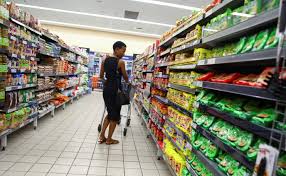Inflation in South Africa rose slightly in April 2025 due to higher food prices, although it remained below the central bank’s official target range. This is according to new data released by Statistics South Africa on Wednesday.
The headline consumer inflation rate stood at 2.8 per cent year-on-year in April, up from 2.7 per cent recorded in March. On a month-on-month basis, inflation was 0.3 per cent in April, slightly lower than the 0.4 per cent reported in the previous month.
The small increase in inflation came as food and non-alcoholic beverage prices rose sharply. According to Statistics South Africa, food-related inflation reached 4.0 per cent in April, the highest annual rate since September 2024. Rising food prices have become a major concern for both consumers and policymakers, especially given South Africa’s high levels of poverty and unemployment.
Most economists had expected inflation to remain unchanged at 2.7 per cent in April. A Reuters poll of economists before the data release also predicted that inflation would stay below the South African Reserve Bank’s (SARB) target range of 3 per cent to 6 per cent.
The increase in food prices is coming at a time when there is growing debate within South Africa’s government about changing the inflation target. Deputy Finance Minister, Mr David Masondo, said last week that the government may announce a new inflation target soon. This statement has sparked speculation that the issue might be addressed in the upcoming budget presentation.
Governor of the South African Reserve Bank, Mr Lesetja Kganyago, has consistently supported the idea of lowering the country’s inflation target. According to him, reducing the target would help make the economy more competitive and stable. However, the Minister of Finance, Mr Enoch Godongwana, has been cautious about such a move. He argued that a lower target could be risky for an economy struggling with deep-rooted poverty and high unemployment levels.
As the government considers changes to inflation policy, the financial markets have started reacting. The South African rand strengthened in recent days due to expectations that a lower inflation target might be introduced. Analysts believe that if the Treasury sets a new target, it could limit the chances of further interest rate cuts by the central bank.
An economist with Capital Economics, Mr Jason Tuvey, said on Wednesday that any announcement of a new inflation target could influence the central bank’s next move. “If the Treasury announces a lower inflation target as part of the budget later today, it’s likely that the SARB will stay on the sidelines for some time,” he said.
The South African Reserve Bank is expected to announce its next monetary policy decision on May 29, 2025. In its last meeting held in March, the bank kept its main lending rate unchanged. That decision followed three earlier rate cuts and was influenced by several global and local factors. These included trade policy uncertainties from the United States and disagreements within South Africa over budget spending.
Economic analysts believe that while the recent rise in inflation is small, the increase in food prices is a key issue for households. South Africans, especially low-income earners, spend a large portion of their income on food, so rising costs in this category put extra pressure on their daily lives.
As the country awaits the upcoming budget announcement and the next central bank decision, attention remains on whether inflation will stay low and what steps the government and monetary authorities will take to support the economy.
